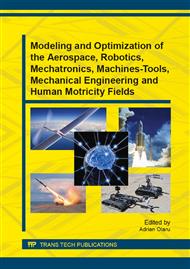[1]
S. P. Mallick et al., Specularity removal in images and videos: A PDE approach, Computer Vision–ECCV 2006, pp.550-563: Springer, (2006).
DOI: 10.1007/11744023_43
Google Scholar
[2]
Y. Weiss, Deriving intrinsic images from image sequences, Computer Vision, 2001. ICCV 2001. Proceedings. Eighth IEEE International Conference on, (2001).
DOI: 10.1109/iccv.2001.937606
Google Scholar
[3]
M. Dellepiane et al., Improved color acquisition and mapping on 3d models via flash-based photography, Journal on Computing and Cultural Heritage (JOCCH), (2010).
DOI: 10.1145/1709091.1709092
Google Scholar
[4]
S. Lin et al., Diffuse-specular separation and depth recovery from image sequences, Computer Vision—ECCV 2002, pp.210-224: Springer, (2002).
DOI: 10.1007/3-540-47977-5_14
Google Scholar
[5]
A. Artusi et al., A survey of specularity removal methods, Computer Graphics Forum, (2011).
Google Scholar
[6]
T. Chen et al., Mesostructure from specularity, Computer Vision and Pattern Recognition, 2006 IEEE Computer Society Conference on, (2006).
DOI: 10.1109/cvpr.2006.182
Google Scholar
[7]
B. Lamond et al., Fast image-based separation of diffuse and specular reflections, ACM SIGGRAPH 2007 sketches, (2007).
DOI: 10.1145/1278780.1278869
Google Scholar
[8]
W. -C. Ma et al., Rapid acquisition of specular and diffuse normal maps from polarized spherical gradient illumination, Proceedings of the 18th Eurographics conference on Rendering Techniques, (2007).
Google Scholar
[9]
A. Agrawal et al., Removing photography artifacts using gradient projection and flash-exposure sampling, ACM Transactions on Graphics (TOG), (2005).
DOI: 10.1145/1073204.1073269
Google Scholar
[10]
G. J. Klinker et al., The measurement of highlights in color images, International Journal of Computer Vision, (1988).
Google Scholar
[11]
K. Schluns et al., Global and local highlight analysis in color images, Proc. 1st Int. Conf. Color Graphics Image Processing, (2000).
Google Scholar
[12]
R. Bajcsy et al., Detection of diffuse and specular interface reflections and inter-reflections by color image segmentation, International Journal of Computer Vision, (1996).
DOI: 10.1007/bf00128233
Google Scholar
[13]
H. -L. Shen et al., Simple and efficient method for specularity removal in an image, Applied Optics, (2009).
Google Scholar
[14]
M. F. Tappen et al., Recovering intrinsic images from a single image, Pattern Analysis and Machine Intelligence, IEEE Transactions on, (2005).
DOI: 10.1109/tpami.2005.185
Google Scholar
[15]
P. Tan et al., Separation of highlight reflections on textured surfaces, Computer Vision and Pattern Recognition, 2006 IEEE Computer Society Conference on, (2006).
DOI: 10.1109/cvpr.2006.273
Google Scholar
[16]
E. Angelopoulou, Specular highlight detection based on the Fresnel reflection coefficient, Computer Vision, 2007. ICCV 2007. IEEE 11th International Conference on, (2007).
DOI: 10.1109/iccv.2007.4409097
Google Scholar
[17]
S. Lin et al., Highlight removal by illumination-constrained inpainting, Computer Vision, 2003. Proceedings. Ninth IEEE International Conference on, (2003).
DOI: 10.1109/iccv.2003.1238333
Google Scholar
[18]
P. Koirala et al., Highlight removal from single image, Advanced Concepts for Intelligent Vision Systems, (2009).
Google Scholar
[19]
W. Li et al., Automated image analysis of uterine cervical images, Medical Imaging, (2007).
Google Scholar
[20]
A. C. Bovik, Handbook of image and video processing: Academic Press, (2010).
Google Scholar
[21]
R. T. Tan et al., Separating reflection components of textured surfaces using a single image, Pattern Analysis and Machine Intelligence, IEEE Transactions on, (2005).
DOI: 10.1109/tpami.2005.36
Google Scholar
[22]
H. Lange, Automatic glare removal in reflectance imagery of the uterine cervix, Proc. SPIE, (2005).
DOI: 10.1117/12.596012
Google Scholar
[23]
J. B. Roerdink et al., The watershed transform: Definitions, algorithms and parallelization strategies, Fundamenta Informaticae, (2000).
DOI: 10.3233/fi-2000-411207
Google Scholar
[24]
G. D. Finlayson et al., Removing shadows from images, ECCV (4), (2002).
Google Scholar
[25]
Z. Xu et al., Image inpainting algorithm based on partial differential equation, Computing, Communication, Control, and Management, 2008. CCCM'08. ISECS International Colloquium on, (2008).
DOI: 10.1109/cccm.2008.89
Google Scholar
[26]
A. Criminisi et al., Region filling and object removal by exemplar-based image inpainting, IEEE transactions on image processing : a publication of the IEEE Signal Processing Society, (2004).
DOI: 10.1109/tip.2004.833105
Google Scholar
[27]
H. Grossauer, A combined PDE and texture synthesis approach to inpainting, Computer Vision-ECCV 2004, pp.214-224: Springer, (2004).
DOI: 10.1007/978-3-540-24671-8_17
Google Scholar
[28]
S. Grover et al., A unified approach for digital image inpainting using bounded search space, International Journal on Graphics, Vision and Image Processing, (2005).
Google Scholar
[29]
P. Pérez et al., Poisson image editing, ACM Transactions on Graphics (TOG), (2003).
Google Scholar


